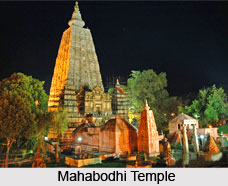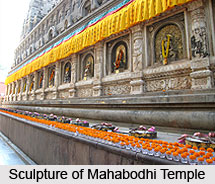 The Mahabodhi Mahavihara or Bodhgaya Stupa was erected in a place where Budhha Shakyamuni is believed to gain enlightenment some two thousand five hundred years ago. The original temple is destroyed in course of time and the present temple was erected by King Ashoka in the third century BC. This temple is the earliest most imposing structure built entirely in brick.
The Mahabodhi Mahavihara or Bodhgaya Stupa was erected in a place where Budhha Shakyamuni is believed to gain enlightenment some two thousand five hundred years ago. The original temple is destroyed in course of time and the present temple was erected by King Ashoka in the third century BC. This temple is the earliest most imposing structure built entirely in brick.
The Temple is a fifty meter tall pyramidal tower crowned with a bell-like structure or `Stupa`.The base of the temple is 15 meter-square, 15 meter in length breadth as well as height and it rises 52 metres in the form of a tapering tower or slender pyramid.. It is a two-storied structure supporting four smaller towers identical to the central counterpart. Inside the temple
there is a colossal gilded statue of Shakyamuni Buddha who is sitting in meditation touching the earth (Bhumisparsha Mudra). The statue is seventeen hundred years old and faces east towards the place where originally Buddha was seated with his back to the Bodhi tree where he was enlightened with deep insights. Along the northern wall of the Mahabodhi temple there is a raised walkway known as the `Chankramana Chaitya`or the `Jewel Path`- where the Buddha meditated as he walked.
 Adjacent to the temple there is a lotus pond, which is believed to be the place where Lord Buddha performed his ablutions.
Adjacent to the temple there is a lotus pond, which is believed to be the place where Lord Buddha performed his ablutions.
Around the temple there is a two metre high stone railing on all four sides. The railing is of two types, which can be distinguished by style and material. The older is made of sandstone and was built around 150 BC while the latter dates back to Gupta Period (300-600 AD) and is constructed of coarse granite. The older set of railing has a number of designs, which includes the scene like purchase of Jetavana Grove by Ananthapindika at Sravasti, Lakshmi being bathed by elephants, Surya riding a chariot drawn by four horses and also numerous other scenes. On the latter part of the railing lotus motifs are most widely used as well as there are figures of Stupas and Garudas.



















